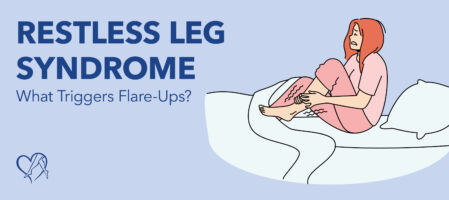
Restless legs can be more than just an annoying sensation. They can significantly disrupt your quality of life, making it hard to relax, fall asleep, or even sit through a long car ride. If you’ve ever found yourself constantly moving your legs to get comfortable or feeling a nagging urge to stretch them, especially at night, you might be experiencing restless leg syndrome (RLS).
Don’t let restless legs keep you up at night or hold you back during the day. Take the first step toward relief—schedule a consultation with a vein specialist at Center for Vein Restoration (CVR). With over 110 locations nationwide, our board-certified vein doctors can help you uncover the root cause of your symptoms and find practical, personalized solutions.

Reclaim your comfort and enjoy better sleep (and a better quality of life!)
In this blog, we’ll uncover the hidden causes of restless leg flare-ups and share practical tips for finding lasting relief.
Restless leg syndrome (RLS), also known as Willis-Ekbom disease, is a neurological disorder characterized by uncomfortable sensations in the legs and an irresistible urge to move them. According to the National Institute of Neurological Disorders and Stroke (NIH), these urges typically worsen in the late afternoon or evening, severely disrupting sleep, leading to exhaustion, daytime sleepiness, mood changes, difficulty concentrating, memory problems, and even depression or anxiety.
While some people experience mild symptoms only once or twice a week, those with more severe RLS may struggle with nightly symptoms that significantly impact their quality of life and daily functioning.
Common Symptoms of Restless Leg Syndrome:
While RLS can occur on its own, it is sometimes linked to underlying medical conditions, including vein problems like varicose veins and chronic venous insufficiency (CVI).
Don’t let vein problems keep you up at night. Center for Vein Restoration’s board-certified vein specialists offer advanced treatments that address the root cause of restless legs, helping you find lasting relief. Schedule your consultation today and take the first step toward healthier, more comfortable legs.

According to the Cleveland Clinic, RLS symptoms often worsen at night due to natural variations in dopamine levels. Dopamine, a brain chemical that helps control muscle movement, follows a daily cycle, with levels typically peaking in the morning and gradually declining throughout the day. This decrease in dopamine in the evening can lead to more pronounced muscle twitching, involuntary movements, and uncomfortable sensations characteristic of RLS.
Additionally, lying down or resting for extended periods, which is more common at night, can further aggravate RLS symptoms by reducing overall circulation and increasing pressure in the legs.
Yes, vein problems can be a significant contributor to restless leg symptoms. Chronic venous insufficiency, a condition where the veins in the legs struggle to return blood to the heart, can cause leg swelling, heaviness, and restlessness.
The Cleveland Clinic states that when vein valves become weakened or damaged, blood pools in the legs, increasing pressure in the veins and causing uncomfortable sensations that can mimic RLS.
A study presented at the American Venous Forum in 2020 reported that 78 percent of patients with superficial venous insufficiency also experienced RLS symptoms, compared to 44 percent without venous disease. This suggests a 34.5 percent higher prevalence of RLS in patients with venous reflux.
Signs that your restless legs may be vein-related include:
Legs that feel full or heavy
Poor circulation is linked to vein disease and restless legs. When blood pools in the lower legs, it increases pressure in the veins, causing inflammation and discomfort. This can lead to the “creepy-crawly” or “itchy” sensations often associated with restless legs.
Treating the underlying vein disease can often reduce or eliminate RLS symptoms, providing lasting relief.
According to a study published by the National Library of Medicine (NIH), patients who underwent ultrasound-guided foam sclerotherapy (USGFS) for LSVP insufficiency experienced significant relief from RLS symptoms, with 93 percent maintaining improvement at one-year follow-up.
Find Lasting Relief from Restless Legs
Center for Vein Restoration (CVR) is the trusted choice for diagnosing and treating vein disease, including conditions that may contribute to restless legs. Schedule a consultation with a board-certified vein specialist today to get to the root of your symptoms and experience real, lasting relief.
📞 Call CVR at 240-965-3915
📅 Or book online HERE
While vein disease is a common cause, other factors can also contribute to restless leg syndrome, including:
If you experience restless legs, there are steps you can take to reduce flare-ups and improve your overall vein health:
If your restless legs are becoming more frequent or severe, or if you have other signs of vein disease like leg swelling, heaviness, or visible varicose veins, it’s time to see a vein expert. A vein doctor can evaluate your symptoms, check for signs of chronic venous insufficiency, and recommend personalized, minimally invasive vein treatments to provide lasting relief.
At Center for Vein Restoration, our board-certified vein specialists use advanced diagnostic tools, such as duplex ultrasound, to assess your vein health and identify the root cause of your symptoms.
Minimally invasive vein treatment options may include:
If restless legs keep you up at night or affect your quality of life, don’t wait! Schedule a consultation with a vein specialist at Center for Vein Restoration. With over 110 locations nationwide, our team of vein experts is dedicated to helping you find relief from vein-related restless leg symptoms and improving your overall vein health.
Call 240-965-3915 or BOOK ONLINE TODAY to take the first step toward healthier, more comfortable legs.
